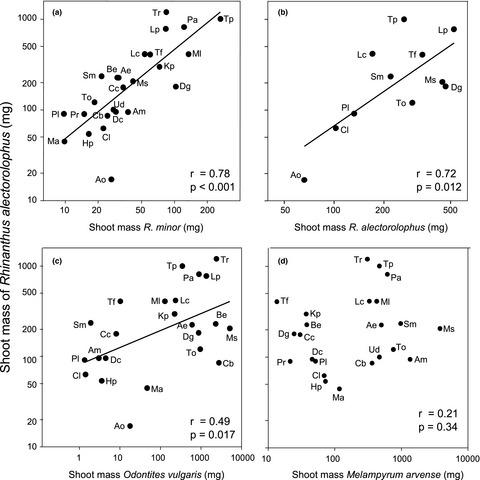当前位置:
X-MOL 学术
›
Ecol. Evol.
›
论文详情
Our official English website, www.x-mol.net, welcomes your feedback! (Note: you will need to create a separate account there.)
Closely related parasitic plants have similar host requirements and related effects on hosts
Ecology and Evolution ( IF 2.6 ) Pub Date : 2021-07-31 , DOI: 10.1002/ece3.7967 Diethart Matthies 1
Ecology and Evolution ( IF 2.6 ) Pub Date : 2021-07-31 , DOI: 10.1002/ece3.7967 Diethart Matthies 1
Affiliation

|
The performance of root hemiparasites depends strongly on host species identity, but it remains unknown whether there exist general patterns in the quality of species as hosts for hemiparasites and in their sensitivity to parasitism. In a comparative approach, the model root hemiparasites Rhinanthus minor and R. alectorolophus were grown with 25 host species (grasses, forbs, and legumes) at two nutrient levels. Hosts grown without parasites served as a control. Host species identity strongly influenced parasite biomass and other traits, and both parasites grew better with legumes and grasses than with forbs. The biomass of R. alectorolophus was much higher than that of R. minor with all host plants and R. alectorolophus responded much more strongly to higher nutrient availability than R. minor. The performance of the two species of Rhinanthus with individual hosts was strongly correlated, and it was also correlated with that of R. alectorolophus and the related Odontites vulgaris in previous experiments with many of the same hosts, but only weakly with that of the less closely related Melampyrum arvense. The negative effect of R. minor on host biomass was less strong than that of R. alectorolophus, but stronger relative to its own biomass, suggesting that it is more parasitic. The impact of the two parasites on individual hosts did not depend on nutrient level and was correlated. Several legumes and grasses were tolerant of parasitism. While R. minor slightly reduced mean overall productivity, R. alectorolophus increased it with several species, indicating that the loss of host biomass was more than compensated by that of the parasite. The results show that closely related parasites have similar host requirements and correlated negative effects on individual hosts, but that there are also specific interactions between pairs of parasitic plants and their hosts.
中文翻译:

密切相关的寄生植物对寄主有相似的寄主要求和相关影响
根半寄生虫的表现在很大程度上取决于宿主物种的特性,但作为半寄生虫宿主的物种的质量及其对寄生的敏感性是否存在一般模式仍然未知。在比较方法中,模型根半寄生虫Rhinanthus minor和R. alectorolophus在两种营养水平下与 25 种寄主物种(草、杂草和豆类)一起生长。没有寄生虫生长的宿主作为对照。宿主物种身份强烈影响寄生虫生物量和其他性状,两种寄生虫在豆科植物和禾本科植物中比在杂草中生长得更好。R. lelectolophus的生物量远高于R. minor的所有寄主植物和R. lelectolophus与R. minor相比,对更高的养分利用率反应更强烈。2种Rhinanthus与个体寄主的表现有很强的相关性,并且在之前对许多相同寄主的实验中,也与R. alectorolophus和相关的Odontites vulgaris的表现有很强的相关性,但与不太密切的R. alectorolophus和相关的Odontites vulgaris的相关相关的Melampyrum arvense。R. minor对宿主生物量的负面影响不如R. lelectolophus 强,但相对于其自身的生物量更强,表明它更具寄生性。这两种寄生虫对个体宿主的影响不依赖于营养水平,而是相关的。一些豆科植物和禾本科植物能够耐受寄生。虽然R. minor 的平均总体生产力略有降低,但R. alectorolophus在几个物种中增加了它,表明寄主生物量的损失被寄生虫的损失所补偿。结果表明,密切相关的寄生虫具有相似的寄主需求和对单个寄主的相关负面影响,但成对的寄生植物与其寄主之间也存在特定的相互作用。
更新日期:2021-09-09
中文翻译:

密切相关的寄生植物对寄主有相似的寄主要求和相关影响
根半寄生虫的表现在很大程度上取决于宿主物种的特性,但作为半寄生虫宿主的物种的质量及其对寄生的敏感性是否存在一般模式仍然未知。在比较方法中,模型根半寄生虫Rhinanthus minor和R. alectorolophus在两种营养水平下与 25 种寄主物种(草、杂草和豆类)一起生长。没有寄生虫生长的宿主作为对照。宿主物种身份强烈影响寄生虫生物量和其他性状,两种寄生虫在豆科植物和禾本科植物中比在杂草中生长得更好。R. lelectolophus的生物量远高于R. minor的所有寄主植物和R. lelectolophus与R. minor相比,对更高的养分利用率反应更强烈。2种Rhinanthus与个体寄主的表现有很强的相关性,并且在之前对许多相同寄主的实验中,也与R. alectorolophus和相关的Odontites vulgaris的表现有很强的相关性,但与不太密切的R. alectorolophus和相关的Odontites vulgaris的相关相关的Melampyrum arvense。R. minor对宿主生物量的负面影响不如R. lelectolophus 强,但相对于其自身的生物量更强,表明它更具寄生性。这两种寄生虫对个体宿主的影响不依赖于营养水平,而是相关的。一些豆科植物和禾本科植物能够耐受寄生。虽然R. minor 的平均总体生产力略有降低,但R. alectorolophus在几个物种中增加了它,表明寄主生物量的损失被寄生虫的损失所补偿。结果表明,密切相关的寄生虫具有相似的寄主需求和对单个寄主的相关负面影响,但成对的寄生植物与其寄主之间也存在特定的相互作用。


























 京公网安备 11010802027423号
京公网安备 11010802027423号